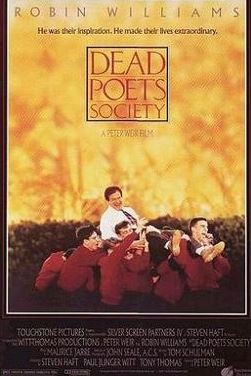Dead Poets Society” (1989), starring Robin Williams, tells the story of a teacher who wants to nurture not just the academic performance but the lives of his students. Let’s listen to a somewhat lengthy quote from Mr. Keating as he points to pictures of alumni who have already graduated, speaking to his students.
John Keating: They’re not that different from you, are they? Same haircuts. Full of hormones, just like you. Invincible, just like you feel. The world is their oyster. It’s all about what you make of it. They believed they were destined for great things, just like many of you, their eyes full of hope, just like yours. Did they wait until it was too late to make even one iota of what they were capable of from their lives? Because, you see gentlemen, these boys are now fertilizing daffodils. But if you listen real close, you can hear them whisper their legacy to you. Go on, lean in. Listen, do you hear it? – – Carpe – – hear it? – – Carpe, carpe diem, seize the day boys, make your lives extraordinary.
In simpler terms, for non-native English speakers, mastering English involves learning how to effectively communicate questions or curiosity about ‘who’ or ‘what’ after stating the subject and the action. Once you achieve this, you’ve fundamentally grasped the essential aspects of English communication. Schools teach this as the five patterns of English sentences. Let’s revisit these five sentence structures:
- Pattern 1: S + V
- Pattern 2: S + V + C (complement)
- Pattern 3: S + V + O (object)
- Pattern 4: S + V + I.O (indirect object) + D.O (direct object)
- Pattern 5: S + V + O (object) + O.C (object complement)
To make it clearer: Patterns 4 and 5 in English sentence structure allow us to detail both “who” is involved and “what” is happening in a single framework. Importantly, “who” doesn’t always refer to an actual person; it can also be something personified or given human qualities. These patterns emphasize the subject or entity affected by the action described by the verb.
For example, take Mr. Keating’s advice in “Make your lives extraordinary.” Here, “your lives” represents “who,” urging you to transform your lives into something remarkable.
S + V + (Who + What) + [Where + Why + How + When]
Consider this quote from “Jerry Maguire” (1996) where Jerry talks to his colleagues as he’s leaving the company:
Jerry: I’m starting a new company, and the fish will come with me and… you can call me sentimental. But if anybody else wants to come with me, this moment will be the ground floor of something real and fun and inspiring and true in this godforsaken business and we will do it together! Who’s coming with me besides… “Flipper” here?
The phrase “They call me Mister Tibbs” illustrates that typically, a name or nickname (a noun) is anticipated to follow “They call me,” forming the structure “to call someone as/to something.”
However, it’s also possible to use adjectives like “sentimental” in this construction, indicating how adjectives can function as object complements. These adjectives describe or rename the direct object, often to express a change, establish a condition, or maintain a state. Verbs frequently used in these contexts include “make,” “leave,” “paint,” “keep,” among others, to achieve this effect.
A Jewish Barber: You, the people have the power to make this life free and beautiful! <The Great Dictator, 1940>
Don Michael Corleone: Keep your friends close, but your enemies closer. (The Godfather II, 1974)
Also, verbs used in pattern 4 that typically follow “to give someone something” can become expressions of pattern 5 when followed by adjectives.
Marty McFly: I know, you did send me back to the future, but I’m back – I’m back from the future. <Back to the Future, Part II (1989)>
Next, look at this line:
Agent J: You know the difference between you and me? I make this look good. <Men in Black, 1997>

“I make this look good” is an expansion of “I make this good,” adding a verb that makes the expression more dynamic. It’s helpful to think of it as if a verb similar to “be” is implied but omitted in front of the adjective. Alternatively, you can add such verbs explicitly. For example, “Make your lives extraordinary” could also be expressed as “Make your lives become extraordinary.”


답글 남기기